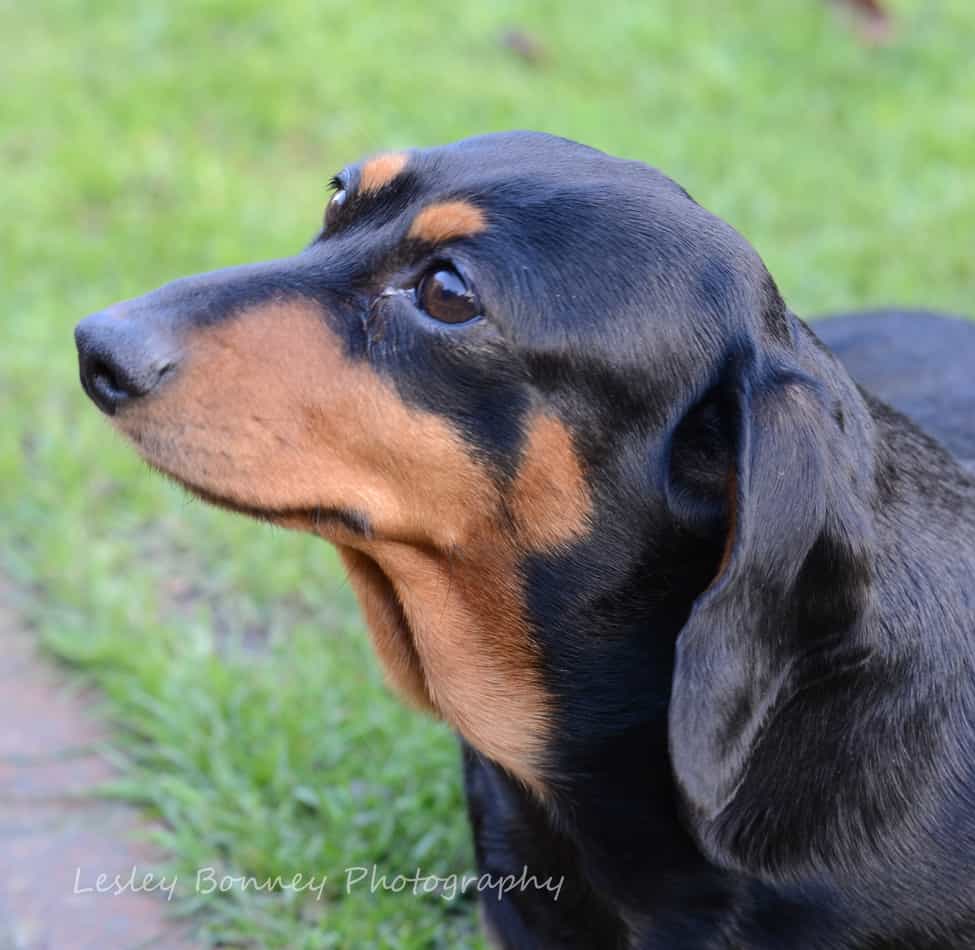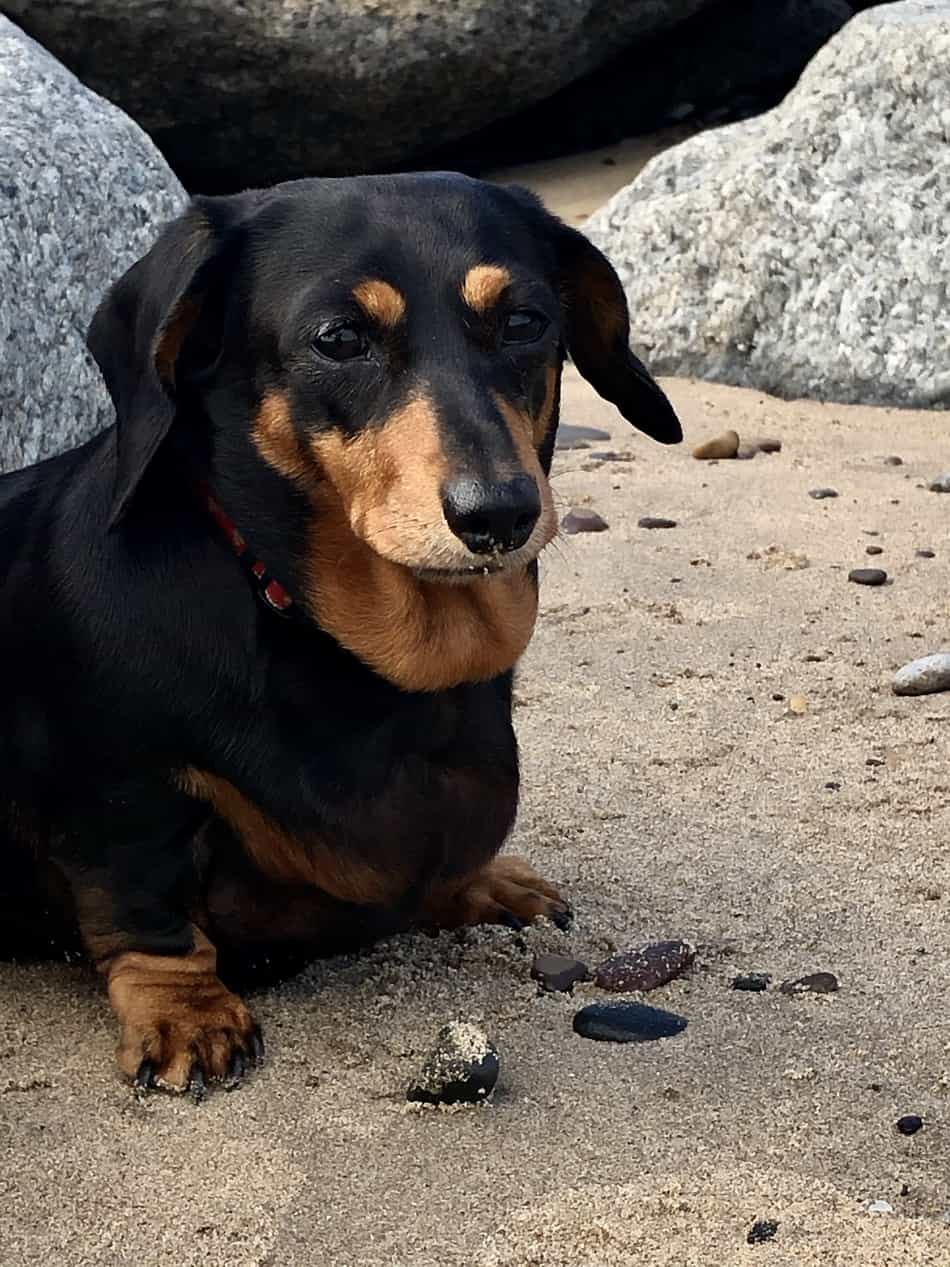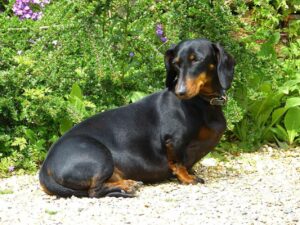Intervertebral is a common spinal condition in Dachshunds and other breeds with long backs. It happens when the disc between the vertebrae in the spine becomes herniated or ruptured, causing pain, weakness, and sometimes paralysis.
This article gives a basic insight into IVDD and a real-life story about Penny, a Dachshund who suffered from IVDD, faced surgery and post-operative care, including physiotherapy and hydrotherapy.
We look at the signs of IVDD and the steps to prevent a dog from developing the condition.
About the Dachshund
Penny is a typical Dachshund – happy personality, lively and courageous (particularly with bigger dogs), devoted, clever and sometimes stubborn. The breed, originating in Germany, is known by various names:
- Sausage dog
- Wiener
- Badger dog
The breed has nine different fur colours, with fur either wire, long or smooth.
- Black and tan
- Black
- Chocolate and cream
- Chocolate and tan
- Cream
- Blue and tan
- Tan
- Red
Their subcategory size is known as standard or miniature, and this means their weight will vary too. The Breed Standard (for showing) is as follows:
- Miniatures 4.5kg with a maximum weight 5kg
- Standard 9 to 12kg
In general, sizing is as classed as follows:
- Obese = 15% above an ideal body weight
- Overweight = 10% to 15% above an ideal body weight
- Ideal body weight
- Thin = 10% to 20% below the ideal body weight
- Very thin = 20% below the ideal body weight
On average, the Dachshund will live between 12 and 16 years old, while some have lived to 20.
What are the signs that a Dachshund has back pain and movement issues

19% to 24% of Dachshunds are likely to develop IVDD, especially in old age. Type 1 and 2 are based on the severity of IVDD, and in the early stages of Type 1, a dog may show signs of back or neck pain, so it is important to be observant of the condition and signs. The Dachshund is more likely to develop IVDD because of its long back.
Signs that your Dachshund has back pain and issues:
- Inactivity
- Discomfort
- Yelping
- Shivering
- Panting
- Arched back
- Unable to bend to reach a food bowl
- Holding the neck low
- Incontinence
- Limping
- Paralysis
Signs of pain and problems in movement do not necessarily show immediately and instead can manifest up to five days after an accident.
Penny:
Penny has a ramp to exit and enter the house. On the day of her paralysis, her owners called to her, but she sat on the patio in silence. Unable to get her to stand, her owners visited the veterinary practice. It is unknown what causes IVDD, but it can be simple physical movements such as jumping and climbing.
What is Intervertebral Disc Disease (IVDD)?
The intervertebral discs are shock absorbers between the spinal cord’s vertebrae and can bulge or burst. With the nerves pressed in the spinal cord, a dog will feel great pain from nerve damage and the disks. Furthermore, paralysis and incontinence are other factors.
What are the two levels of IVDD?
Type 1: mild to moderate with the opportunity of healing and resuming a normal life.
Type 2: severe, resulting in paralysis and incontinence, and surgery is vital for the chance of recovery. A veterinary surgeon must operate to relieve pressure on the spinal cord.
Some Dachshunds may inherit IVDD, while others are 12 times more likely to suffer when compared to other breeds. There are ways to reduce the risk of Intervertebral Disc Disease by adopting the best lifestyle choices for your Dachshund.
Recommended ways to reduce the risk of IVDD:
- Regular exercise Dachshund and increase as your pup matures (unless elderly)
- Walk with a fitted harness – our selection has been tried and tested for general use
- Maintain an ideal body weight (your vet can advise)
- Ensure your Dachshund is not overweight
- Feed your dog a balanced healthy diet
What is the cost of treatment for IVDD?
Treatment can cost thousands, so it is important to insure your Dachshund. A dog will most likely have an MRI scan and stay in a veterinary hospital for up to two weeks after an operation. Anti-inflammatories will be prescribed, possibly steroids and a dog will need post-op checkups. Type 1 or 2 is serious and your vet will treat your dog according to severity.
A dog with IVDD requires crate rest for 6 to 7 weeks. Opt for a folding crate as it can be easily stored away when no longer required. Cheeko is a brand I have used and can be used in a vehicle too. Crates can be disguised as furniture with a unique wooden topper. Physiotherapy is necessary whether by a professional or shown by the vet and performed at home two to three times daily. A dog may be required to have hydrotherapy too. Again, insurance is important – some insurance companies, like Fluffy Pet Insurance, offer a FREE online video vet and referral system.
Penny:
Penny was not insured. The MRI scan revealed a bulging disc pushing at her spinal cord. The IVDD happened a few years ago and cost £4000. Like everything in 2023, veterinary costs have catapulted, and charges for IVDD treatment will have increased.
She was prescribed Gabapentin for anxiety and nerve pain, had physiotherapy at home and attended weekly hydrotherapy classes.
What is the prognosis of IVDD?

The problem can re-occur. Tripping may be apparent, so a vet will suggest ways to exercise these areas. Disc issues in other parts of the back may develop, or general back pain.
It is essential to keep up with regular checkups so a dog can be accessed and any future problems can be dealt with before any severity.
Occasionally, a dog may not recover as hoped and further tests may be required.
Penny:
Penny responded to physiotherapy and hydrotherapy, and the vet monitored her with regular checkups, eventually signing Penny off. Penny walks regularly, enjoys a healthier eating plan and has lost weight. She runs, too. Her owners continue to monitor her and they ensure she does not clamber onto the sofa unsupervised
Visit Dachshund IVDD for more information.
Disclaimer
This article does not give medical veterinary advice. Please consult your licensed veterinary surgeon for professional medical advice, who will advise on health tests for your pet.
Poppy’s Pets has a column in an East Yorkshire newspaper.

